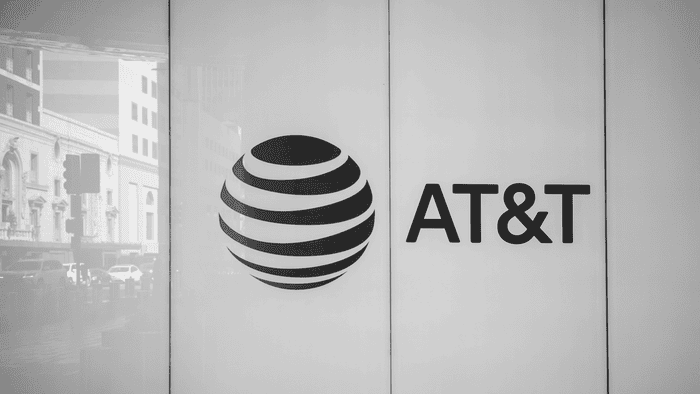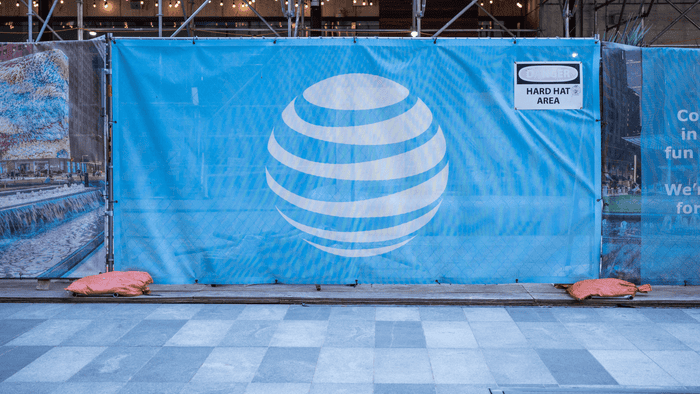An inside look at AT&T's 5G and fiber focus
The company that once urged us to celebrate 'Batman Day' is again focused on being one of the world's leading network providers.

DALLAS – Earlier this month, AT&T gave a few journalists a chance to see what the telecom network of 100 years ago looked like (some of it is still operational). We also got to hear what the near future holds for AT&T's edge computing plans, which aim to blend its fiber and 5G networks to power a world-beating portfolio of network services.
As a nod to its past, our hosts whisked us through a Dallas central office located in a neighborhood between Deep Ellum and Lower Greenville. It was a cathedral of no-excuses, always-on connectivity.
Sitting at the ready are rooms of backup batteries and entire buildings housing industrial gas-powered generators. There are rows of switches, servers and what looked like thousands of miles of wires that, at this moment, no one needs at all. But, when needed, the whole operation cranks up and crackles to life, so the people on the other end of hundreds of thousands of regional phone and broadband connections never know the difference.
Figure 1:  The AT&T logo at the company's Dallas headquarters building. The reflection shows the traffic piling up on Commerce Street.
The AT&T logo at the company's Dallas headquarters building. The reflection shows the traffic piling up on Commerce Street.
(Source: Phil Harvey/Light Reading)
AT&T seems eager to return to those more industrial roots, but only in its attitude and focus. Technology is remarkably different now, but the drive to connect everyone with resilient networks is constant. The carrier's newly promoted executives, several of whom have arrived from other industries, see AT&T as a company focused on 5G and fiber.
Longer-tenured AT&T execs and industry watchers have learned to unsee the decades of distractions from a company that aspired to be an advertising firm, a public cloud provider, a pay TV colossus, and more. It started and stopped all those clumsy grasps at growth with the patience of a bored billionaire teenager.
And, of course, there was AT&T's entertainment company cosplay. The carrier once sent us a press release celebrating "Batman Day." It bought WarnerMedia for $85 billion in a 2016 deal and then shed the entertainment group via a deal that combined the WarnerMedia business with Discovery to form a new company. The series finale of AT&T's media moves aired in April.
“We are at the dawn of a new age of connectivity, and today marks the beginning of a new era for AT&T,” stated John Stankey, AT&T's CEO.
To the edge and back
Before the central office tour, we were briefed by several AT&T managers on technology, security, consumer business, its FirstNet operations and its business services. Every single executive talked about how AT&T was building out services closer to customers, shoring up its network edge and using the cloud and improving operations to make delivering and consuming networks simpler.
A big part of that journey is AT&T's network cloud and its appetite for what it calls the multiservice edge. The company's CTO, Jeremy Legg, said that AT&T can have a real competitive advantage as it builds out its network, blending its wireline and wireless networks "in municipalities and edges around the country." That kind of distributed network makes "a very big difference in terms of how traffic is routed around and the capabilities that begin to get delivered," he said.
He noted three things AT&T is doing to create the modern network edge. The first is to use software-based routing and white boxes with Linux-based operating systems. AT&T's network cloud, a key component of its multiservice edge, long ago rejected proprietary gear that would result in the company losing control of how fast it could respond to new demands on its network operations.
The second edge "must have" is the 5G standalone core. AT&T wants to "federate where those cores sit" and create an environment where services are available whenever needed and at the lowest latency required by the application. With millions more devices connecting to its networks at increasing frequency, Legg said these software-based 5G cores could go closer to where people and services meet – and in greater numbers as use cases demand it.
The third characteristic of AT&T's edge approach is its evolving, strategic relationship with cloud providers. "We don't want the compute and storage of the applications that run on our network to be served by us," he said. "We want the people that build those applications to run wherever they want them to run. They can run them in a private data center. They can run them in Azure, Amazon, Google, or wherever they want to run them. That's fine with us."
AT&T, Legg said, wants to be the network access layer, building connections between the edge locations and its customers, running the applications and software they need. Legg said AT&T is "agnostic" to where its customers want to house and run their applications (private data centers, the public cloud, etc.). Still, it wants to help them ensure those applications can be delivered wherever they need them.
Figure 2:  The AT&T Discovery District has dining options, live music and art installations in between the company's offices and some grand old hotels.
The AT&T Discovery District has dining options, live music and art installations in between the company's offices and some grand old hotels.
(Source: Phil Harvey/Light Reading)
Clouds and clear thinking
Several executives noted that the carrier is also partnering with cloud providers because it no longer believes that developers will build exclusive network services just for AT&T (or any other carrier). The public cloud is "where the developers are, and that's where the compute and storage is," Legg said.
Legg said AT&T wants to make its network "accessible to third parties, so they can help us build" new network services and applications. The company's network cloud can operate and run those network services and it can make those applications available to customers via its multiservice edge.
Even for consumers, Legg said AT&T is trying to be more accessible in a way only a network operator can. "Networks have not traditionally been easy to work with," he said. "And so we got to simplify the process and give consumers tools to do that."
Number | Item |
16 | Number of AT&T's enterprise data centers. The company will consolidate to six data centers over the next five years. |
675,000+ | US business buildings are now lit with fiber from AT&T, reaching about 3 million business locations. |
18 million | Number of customer locations reached with AT&T Fiber in more than 100 US metro areas. |
281 million | Number of Americans in over 22,000 cities and towns reached by AT&T's 5G network. |
3.7 million | Approximate number of FirstNet connections across more than 21,800 agencies. |
30+ million | Number of customer locations (consumers and businesses) AT&T expects to cover via its fiber network by the end of 2025. |
53.3 million | Connected cars on AT&T's network as of 2Q22. |
|
Fiber forward
In the central office tour, led by Chris Sambar, AT&T’s EVP for Network, all aspects of AT&T's network were covered and the excitement about that network's future was palpable.
After covering the path a copper pair would take from a house to a phone switch to a long-distance network, the conversation shifted to AT&T's fiber focus. Mark Castleberry, Area Manager, AT&T Network, held up an enclosure containing 432 fiber optic strands, each capable of carrying up to 88 different optical channels. "It is just unbelievable what we can do with this," he said. "And we haven't even reached the limits yet; the only limit is our technology."
Another highlight was seeing what AT&T's network cloud looks like as a stack of white boxes, whirring away in a cold room where real network functions were running on AT&T's 5G network. The carrier's own disaggregated distributed chassis (DDC) design was on display.
Not long ago, a service provider like AT&T would buy a chassis – "a standalone single bay with 16 line cards in it" – load it up with line cards or server blades and add new line cards or blades for power, cooling and each new service, interface or capacity change. Those line cards would connect to the router's fabric cards through an electrical backplane.
AT&T's DDC uses standalone white boxes (each with a power supply, fans, etc.) to replace the line cards; those boxes can be swapped out. External cabling snakes around the chassis to supply backplane connectivity. The resulting network cloud instance can be deployed wherever it needs to be close enough to a customer location – even if, in one extreme example offered by our tour guides, that meant packing the kit in a modified shipping container and running it in a parking lot.
The point was that capacity and physical configuration are now not limited by the single, monolithic chassis. "Our old way of doing things was ten times the cost of using a white box platform," explained Steve Batson, an AT&T communications technician, over the din of fans cooling the small data center inside the central office.
Batson said that AT&T uses three different configurations of its network cloud platform, all linked by 400Gbit/s fabric connections for routing. He said the carrier upgraded from 100Gbit/s links to 400Gbit/s while honing its network cloud infrastructure.
Resiliency, too, is the name of the game. "We have both on-site and off-site operating system copies – each site is redundant," Batson said. Sambar added that the new design of AT&T's network allows it to be fully operated remotely, allowing for faster software deployment and more efficient management of the overall network.
AT&T's journey to being more focused on connectivity at the edge and more cloud-centric isn't new, nor unique to AT&T. "AT&T was an early leader in the global telecom industry's shift to software defined networking (SDN) and virtualized network function (VNF)," Light Reading reported in 2021. The company reached its goal of virtualizing 75% of its network. That work allowed AT&T to transition its network operations from dedicated, purpose-built hardware to software that can run on standard, off-the-shelf computers.
In 2019, AT&T named Microsoft as its preferred cloud provider for "non-network applications," Light Reading's Mike Dano reported. In 2020 it began a cost-cutting plan that, in part, included "IT rationalization," corporatespeak for simplifying its network, using the cloud more and getting rid of non-core network applications and IT projects.
Figure 3:  The build out continues...
The build out continues...
(Source: Phil Harvey/Light Reading)
Edge ready
On the edge front, AT&T is falling in line with the industry trend of moving networking and computing assets closer to new centers of commerce. Competitor Verizon and cloud leader AWS said earlier this year that "75% of the U.S. population is now within 150 miles of a Wavelength Zone," its parlance for a mobile edge computing hub. Verizon and AWS have 19 such sites in the US.
Between AT&T's Legg and Sambar, it was tough to tell which one was more excited by the unknowns of edge computing. Both gave essentially the same big-picture view – one from a conference room in AT&T's headquarters and the other from a concrete bunker within a few feet of a 5ESS Switching System that was probably installed in the 1980s. What they said boils down to this: The connectivity needs of cars, healthcare facilities, government agencies and factory floors are changing fast. The responsiveness, nimbleness and availability of the network that's expected to keep up with those needs has become a build-out mandate for telcos like AT&T – even if the commercial particulars aren't nailed down yet.
Of course, they won't just build for its own sake. But both execs said that the data in their network, strategic customer conversations and the moves of major population centers are quickly identifying some starting logical points. It's unclear how long this edge buildout will keep going, but the work has started and AT&T is picking up the pace.
"You know, scaled, massive industries, and you know, that there's money to be made there," Legg said, responding to a question about who will pay for edge networks. He said it would take longer to figure out what part of the value chain AT&T would play in but added, "one part of this is what we've always done, just sort of on steroids." The other part – the ecosystems, applications and so on – are "part of innovation and new adventures, new marketplaces and new kinds of products; it's super fun."
Cloud control
Where the public cloud ends and AT&T's network begins could shift over the coming years. But the carrier is not troubled by the hybrid cloud complexity and its partnerships with cloud providers seem to have tangible benefits in that AT&T can focus on its running its network operations, network routing, baked-in security and handling its own customer data.
The execs explained that Microsoft's hybrid cloud can now support AT&T's mobility core network workloads and Microsoft sells other carriers a modified version of the AT&T-developed network operating system. AT&T chooses and manages the network applications it wants to deliver to its mobile customers. And it decides what runs on-premises, on the Azure public cloud, in Google's cloud and so on.
At each point of the tour and our hallway discussions, AT&T's network execs make it clear that the carrier is cautiously moving forward, but it's not giving up control. The world may have moved from lead-coated wires and shiny copper to clouds, fiber and 5G, but they still deliver a network, even if its network infrastructure is code on white boxes in the basement of a windowless building.
A lot has changed at AT&T; it was a different company just 18 months ago. But whether you're walking through rooms of giant batteries or staring at unending, refrigerated rows of racks of servers, this much is clear: the network is still the network. "You can see from the old part of the network that our focus on resiliency and redundancy is a step above anyone else," Sambar said.
Related stories and posts:
Also, reported at the AT&T media visit:
AT&T distributes its 5G SA core software across the U.S. (Fierce Wireless)
AT&T CTO strategy update: ‘Simple is good’ (RCR Wireless)
— Phil Harvey, Editor-in-Chief, Light Reading
About the Author(s)
You May Also Like




_International_Software_Products.jpeg?width=300&auto=webp&quality=80&disable=upscale)







